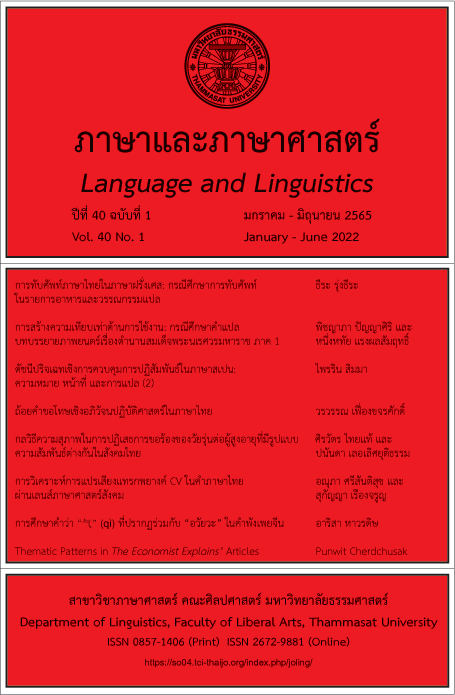Creating Functional Equivalence: The Case of Subtitle Translation of the Legend of King Naresuan the Great, Part I
Main Article Content
Abstract
This study aims to analyze how functional equivalence is created in the subtitle translation of the Legend of King Naresuan the Great, Part I: Hongsawadee's Hostage from Thai to Spanish. To answer this question, forty-nine cases of culture-specific items translated using functional equivalents in the movie were analyzed. The findings indicate that functional equivalence can be created by breaking down the semantic components of the term into a context-specific function and other semantic components. The function of the word, being the vital part in the context of the case study, should be retained to keep the core meaning of the source text unchanged. From this study, three methods are proposed to create functional equivalence of a cultural word: using its superordinate, indicating its function or feature, and using a word denoting a different category of objects or entities with the same function or the same effect as the original word in the same context. The findings of this study can benefit scholars on functional equivalence as well as translators who want to create functional equivalence in their translation, especially to cope with issues of cultural differences.
Article Details

This work is licensed under a Creative Commons Attribution-NonCommercial-NoDerivatives 4.0 International License.
บทความทุกบทความเป็นลิขสิทธิ์ของภาษาและภาษาศาสตร์
References
ณัฐพงษ์ ศิริจันทร์ชื่น. (2563). การแปลคำขยายแบบลดระดับจากภาษาอังกฤษเป็นภาษาไทยในตัวบทประเภทเน้นการแสดงอารมณ์ความรู้สึก. วารสารภาษาและวัฒนธรรม, 39(1), 111-133.
ทินประภา กรดนิยมชัย และภาสุรี ลือสกุล. (2561). การวิเคราะห์องค์ประกอบทางวัฒนธรรมไทยใน “อสรพิษ” ฉบับภาษาสเปน. วารสารการแปลและการล่าม, 3(2), 41-89.
ปาลิตา จุนแสงจันทร์. (2557). แปล(ง) เรื่องให้เป็นเรื่อง: ภาษาศาสตร์ระบบ-หน้าที่กับความตลกในบทละครฝรั่งเศส เรื่อง เดอ กัว ซาฌี ติล (De quoi s’agit-il?) ของ ฌ็อง ตาร์ดิเยอร์ (Jean Tardieu). วารสารอักษรศาสตร์, 43(2), 61-104.
ราชบัณฑิตยสถาน. (2554). พจนานุกรมฉบับราชบัณฑิตยสถาน พ.ศ. 2554. https://dictionary.orst.go.th/
ศิลปวัฒนธรรม. (10 ตุลาคม 2563). การจัดการน้ำในเมืองโบราณของไทย ดูวิทยาการและคติเรื่องน้ำของคนในอดีต. https://www.silpa-mag.com/history/article_38626
Álvarez, A., Arzelus, H., & Etchegoyhen, T. (2014). Towards customized automatic segmentation of subtitles. In J. L. Navarro Mesa, A. Ortega, A. Teixeira, E. H. Pérez, P. Q. Morales, A. R. García, I. G. Moreno, & D. T. Toledano (Eds.), Advances in speech and language technologies for Iberian languages (pp. 229-238). Springer. https://doi.org/10.1007/978-3-319-13623-3_24
Baker, M. (1992). In other words: A coursebook on translation. Routledge.
Díaz-Cintas, J. (2012). Subtitling: Theory, practice and research. In C. Millán & F. Bartrina (Eds.), The Routledge handbook of translation studies (pp. 273-287). Routledge.
Díaz-Cintas, J., & Remael, A. (2007). Audiovisual translation: Subtitling. St. Jerome Pub.
Newmark, P. (1988). A textbook of translation. Prentice-Hall International.
Nida, E. (2000). Principles of correspondence. In L. Venuti (Ed.), The translation studies readers (pp. 126–140). Routledge. (Original work published 1964).
Nida, E. A., & Taber, C. R. (1969). The theory and practice of translation. E. J. Brill.
Pym, A. (2007). Natural and directional equivalence in theories of translation. Target-international Journal of Translation Studies, 19(2), 271-294. https://doi.org/10.1075/target.19.2.07pym
Waard, J. D., & Nida, E. A. (1986). From one language to another: Functional equivalence in Bible translating. Nelson.
Yukol, C. (Director). (2011). Kingdom of war: Part 1 and 2 [Film]. Magnolia Home Entertainment.


